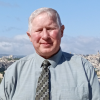

7:00 PM
Matt McBride
Keynote Address – Saints Volume Four
coming soon
Matthew S. McBride is director of the Publications Division of the Church History Department, The Church of Jesus Christ of Latter-day Saints. He earned an MA in American history from the University of Utah. Matt is the author of A House for the Most High: The Story of the Original Nauvoo Temple (2007) and co-editor of Revelations in Context: The Stories behind the Sections of the Doctrine and Covenants (2016). His article on the origins of the women’s missionary program in the church won the Mormon History Association’s Best Article Award for 2018. He was previously the digital content manager for the Publications Division, and prior to that, director of web development and director of digital publishing for Deseret Book Company.

10:00 am
Ben Spackman
Scripture, Science, and History-writing: Elder Ballard’s Subtle—but Radical—Reformation
To what extent is there a human element in revelation, prophethood, scripture, and the interpretation of scripture? Church leaders have taken different stances on that question, which resulted in different Church emphases and approaches. Dividing Church history into four periods, I examine how those different approaches explain shifting Church positions on scripture, science, and history-writing. Understanding this history— how and why these changes happened— helps prepare us for similar changes in the future.
Ben Spackman has a Masters Degree in Semitic Languages and literature from the University of Chicago, and a PhD in American Religious history from Claremont. He researches how the creation accounts of Genesis were understood in the ancient world and the 20th century, as well as fundamentalism, creationism, and religious opposition to evolution. He is turning his dissertation into a book on Latter-day Saints and creationism in the 20th century. He has been involved with FAIR for over 20 years.


10:40 am
Paul Bryner & Spencer Kraus
Rainbows, Stars, and Comets: Joseph Smith and Signs in the Heavens
This paper will consider the biblical background of astronomical and heavenly signs, the historical Christian interpretation of these, the constraints of modern science on the theology of miracles, and how Joseph Smith’s prophecies of heavenly signs interact with this background to combine a bold literalism with an appreciation of symbols.
Paul Bryner is a first-year law student at the S.J. Quinney College of Law at the University of Utah. He received a BA from Brigham Young University in Ancient Near Eastern Studies and took courses in Hebrew, Aramaic, Greek, Latin, Coptic, and Middle Egyptian. In his spare time Paul enjoys reading classic literature and playing the piano.
Spencer Kraus graduated from Brigham Young University with a Bachelor’s degree in Computer Science, modern Hebrew, and Ancient Near Eastern Studies. He works with Scripture Central as a researcher and with Lincoln Blumell on topics relating to early Christianity and the New Testament.

11:30 am
Much discussion, positive and negative, has been had concerning the many visions claimed by Joseph Smith, Jr. However, the Prophet was not the only person to record receiving theophanies, divine visions, dreams, and other intense spiritual experiences in the early days of the newly restored Church of Jesus Christ. Those who allege Smith was lying or deceiving others need to account for over a dozen individuals who received their own independent divine witness of the Restoration.
Sarah Allen is on the research team at Scripture Central and is also a Senior Researcher for FAIR. She responds to anti-Mormon material on the FAIR blog and is a co-host of the Me, My Shelf, & I podcast. She volunteers with the Cavalry missionary group and loves books, Irish history, and true crime podcasts. She is also the 2022 recipient of the John Taylor: Defender of the Faith award.

12:10 PM
A consistent weakness of naturalistic theories attempting to explain the origin of the Book of Mormon is how they oversimplify the number, diversity, and depth of skills Joseph Smith demonstrated while dictating the word stream in 1829. For example, many theorists identify parallels between the content of the Book of Mormon and known publications (e.g., View of the Hebrews, The Late War, etc.) or events in Joseph’s life experiences (e.g., Dan Vogel’s Making of a Prophet), affirming that the parallels explain his ability to produce the entire book. A recent hypothesis alleges that learning to memorize outlines with their subject headings and then recounting them in real-time to a scribe (“laying down heads”) could explain how Joseph completed the dictation in less than three months. The overall inadequacy of these and other naturalistic explanations is apparent when contextualized to all the skills an orator would need to dictate long, complex, and refined narratives. This reality is illustrated as online Artificial Intelligence programs predict the skills needed to produce a book-length manuscript with the literary characteristics of the Book of Mormon (e.g., 269,320 words, 77 storylines, 207 characters, 149 geographical locations, 63 religious discourses comprising over 87,000 words, 170 original proper nouns, etc.). The AI-generated predictions include more numerous, specialized, and intense literary skills than those found in any popular naturalistic theory. Those lists of needed abilities can also be compared to historical descriptions of Joseph Smith’s 1829 skillset to ascertain whether or not history supports his possession at that time.
Brian Hales has published extensively on Joseph Smith and plural marriage. He is currently working on a book-length manuscript exploring Joseph Smith’s 1829 skills and those required to dictate a book like the Book of Mormon. He is a retired anesthesiologist and with this his wife, Janis, will be entering the MTC on October 28th as full-time missionaries assigned to the Utah, Salt Lake City Headquarters mission to work with Rick Turley on the new Joseph Smith biography.

1:20 PM
John Thompson
Looking Again at the Anthon Transcript(s)
The official account of Martin Harris’s visit to Charles Anthon, canonized in the Pearl of Great Price, suggests that Anthon may have been shown more than one transcript by Harris. The differing responses of Anthon to each of these transcripts may shed light on the kinds of characters he was shown and provide additional perspectives that can help clarify a little more what is happening in the historical sources.
John S. Thompson obtained his BA and MA in Ancient Near Eastern Studies (Hebrew Bible) from BYU and UC Berkeley respectively and completed a PhD in Egyptology at the University of Pennsylvania. He was an employee of the Seminaries and Institutes of Religion for 28 years, most recently as a Coordinator and Institute Director in the Cambridge, Massachusetts, area. Now a full-time researcher and writer for Scripture Central, John’s research interests and publications focus primarily on early Egyptian religion, the Book of Abraham, as well as ancient & modern priesthood, temple ritual, and covenant theology. He and his wife Stacey make their home in Orem, Utah, where they welcome their nine children and four grandchildren.

2:00 PM
“John Krakauer described Mormonism as a violent faith, while Dustin Lance Black fell back on old stereotypes depicting members of The Church of Jesus Christ of Latter-day Saints as fanatical and barely containing under the surface a violent, dangerous nature or, as Taylor Petry described when discussing Hulu’s Under the Banner of Heaven series, “”a dark underbelly of Mormonism and its people.””
The late historian, D. Michael Quinn, in his pivotal Sunstone article, “The Culture of Violence in Joseph Smith’s Mormonism,” argued that the early LDS Church was “”a violent religious subculture within a violent national culture.”” Furthermore, he asserted that “”Joseph Smith’s personality and his theocratic teachings were the joint basis for early Mormonism’s norms for violent behavior.””
But, was The Church of Jesus Christ of Latter-day Saints, its leaders, and early members as violent as Black, Krakauer, and Quinn portrayed? Was and is Mormonism really a violent faith? This paper will place Mormonism’s so-called culture of violence in historical and social context and show that despite incidents of violence against and by Latter-day Saints, over all, the history of the Church and its members demonstrates less violence than a large portion of society at that time. “
Craig L. Foster has authored, co-authored, and co-edited seven books. He has authored numerous articles, mostly on LDS history. Among his articles are those dealing with crime and culture of violence, including “The Butler Murder of April 1869: A Look at Extralegal Punishment in Utah,” Mormon Historical Studies; “The Sensational Murder of James R. Hay and Trial of Peter Mortensen,” Utah Historical Quarterly; “Myth Vs. Reality in the Burt Murder and Harvey Lynching,” Journal of the West; “Death to Seducers! Examples of Latter-day Saint-led Extralegal Justice in Historical Context,” Interpreter: A Journal of Latter-day Saint Faith and Scholarship;“The Wrath of a Wronged Woman: Ways Nineteenth Century Women Punished Wrongdoers,” Journal of the Wild West History Association; and, “Turning Type into Pi: The Destruction of the Nauvoo Expositor in Historical Context,” Interpreter: A Journal of Latter-day Saint Faith and Scholarship.

2:50 PM
Allen Hansen
Joseph Smith and the Kabbalah: A New Look at the Evidence
One naturalistic explanation for Joseph Smith’s revelations is that he borrowed from or was influenced by the Jewish esotericism of the Kabbalah and the Zohar, not only during the Nauvoo era, but even for the Book of Mormon. This claim was introduced over 30 years ago by critical scholars, accepted by non-LDS scholars and sympathetic outsiders, as well as embraced by anti-Mormons. I will show that while there are some affinities to the Kabbalah, there is no evidence for any direct influence on Joseph. The claim is untenable. I will look at what was known in America at the time and the availability of Kabbalistic works; whether any books we can trace for certain to Joseph discussed it; and, finally, a new look at Alexander Neibaur’s supposed familiarity with the Kabbalah and a reexamination of the parallels between the Zohar and the King Follett Discourse will demonstrate how he was unlikely to have been the conduit.
Allen Hansen is an independent researcher. He was born and raised in northern Israel. He served a mission in Russia, and married Kateryna from Ukraine. They are parents to a daughter. His research interests include the Bible, ancient, medieval and early modern Jewish literature, Book of Mormon translation, and the meeting points between the church, Judaism, and the history of Israel.

3:30 PM
Stephen Smoot
A Tale of Two Smiths: Joseph Smith, Ethan Smith, and the View of the Hebrews Controversy
This paper will critically reexamine the claims that Joseph Smith was directly influenced by Ethan Smith’s 1823/1825 book “View of the Hebrews”; that Joseph utilized ideas from “View of the Hebrews” in composing the Book of Mormon; and that Oliver Cowdery was the missing link between Joseph and Ethan. This paper will review what we know about “View of the Hebrews,” its reception among Latter-day Saints, and the history of the controversy. It will argue that the case for Joseph Smith’s dependence on Ethan Smith’s book is not as strong as critics have typically argued.
Stephen O. Smoot is a doctoral candidate in Semitic and Egyptian Languages and Literature at the Catholic University of America. He previously earned a master’s degree from the University of Toronto in Near and Middle Eastern Civilizations, with a concentration in Egyptology, and bachelor’s degrees from Brigham Young University in Ancient Near Eastern Studies, with a concentration in Hebrew Bible, and German Studies. He is currently an adjunct instructor of religious education at Brigham Young University and a research associate with the B. H. Roberts Foundation.
